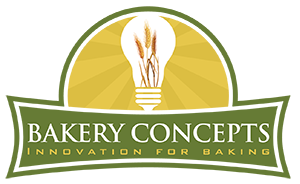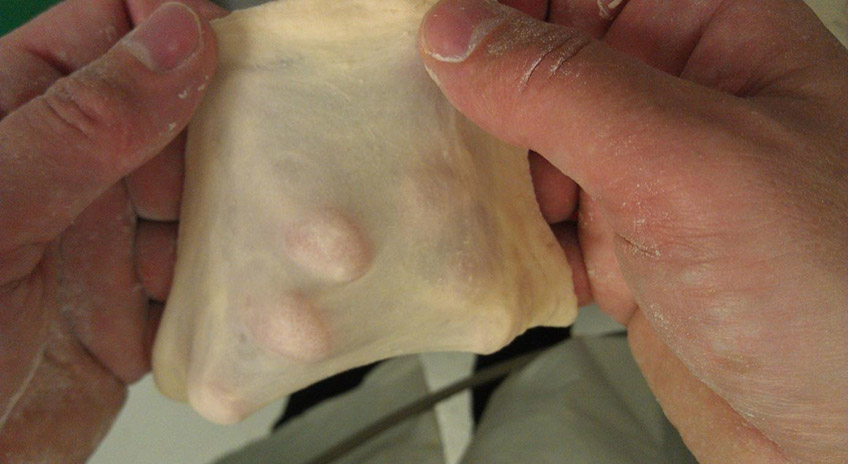The most important food is a simple molecule – water. Alongside its significance as a direct food, it also plays a key role in producing foods. The starting material for further processing is often produced by combining water or other liquids into dry basic ingredients. If the basic substance is flour, then depending on the mixing ratio for a crumbly-dry mass (pasta products), a solid visco-elastic dough for bakery products or a liquid mixture (waffle dough, liquid batter) is the result. If the basic substance is potato flakes or masa, the mixture can be used to make potato mash, stacked crisps, corn chips or other snacks. Gels are made from hydrocolloids. Vegetarian products are used as meat substitutes and are produced from vegetable protein. Until now, there have been very limited and traditional methods for efficiently binding the range of liquid molecules with the range of dry products. Many substances are extremely resistent to hydration.
Moistening / hydration is rendered difficult by a number of factors:
- Many substances are hydrophobic and water runs off
- Other substances are extremely hydrophilic, so that the part that makes contact water first “steals” the water from the rest of the substances
- The surface tension of water prevents the water from spreading well over a surface
- If powder is introduced into water, the water penetrates into the outer layer and forms a gel, so that further penetration is prevented (gel blocking) and as a consequence lumps are formed
- Foods are generally structure-sensitive media whose properties can be irreversibly destroyed by high shear forces
Effective moistening of dry substances is promoted by the following factors:
1. Highly accessible surface area at the time of moistening
2. High speed difference of the substances during moistening
Both requirements can only be satisfied to a very limited extent with a range of existing stirring and mixing tools. A revolutionary disruptive solution has arrived. It is the high-pressure moistening and mixing system called “Rapidojet”. The mode of operation of the patented method is amazingly simple – dry material is conveyed continuously into a vertical mixing tube (volumetrically or gravimetrically) by a dosing unit.
There, it is isolated in free-fall after contacting a deflector cone. The liquid is injected at high speed (250 – 500 km/h) through a high-pressure nozzle and broken down into tiny water droplets that meet the free-falling dry material in the air. Both factors of large accessible surface area and high-speed difference are achieved in the ideal fashion. The high surface area is achieved both by the dry substances that are isolated in free fall and by the surface enlargement due to small water droplets. The high-speed difference ensures an intensive impact, an effect that does not occur with this intensity in any other mixing method. Thus, the water or any other liquid penetrates much more deeply into substances that are traditionally difficult to access.
Despite the intensity of the high-pressure jet, the method is very gentle to products. First of all no shear forces occur – the moistened material leaves the mixing chamber in the form of minute particles, visually perceptible as a kind of “product mist”. The fully hydrated particles only become uniform when they land in the hopper of a pump or some other vessel such as a mixing bowl, trough, etc.
Furthermore, there is practically no increase in product temperature, which is always an undesirable side effect particularly in intensive mixers. However, it is possible to turn the tables here! By using hot water, it is possible to moisten and heat at the same time (“mixing boiler”). In this way starch can be completely gelatinized in just one operation or flour can be processed to a “flour custard” or paste.
An essential feature of high-pressure hydration, because of the more homogeneous bond between drys and liquids, is that the water-binding capacity of the dry substances becomes distinctly higher. For example, in wheat dough the water quantity needed to produce the same consistency and level of machineability is increased by 5-10 %. This effect is also observed with starch. The first applications were still conventional pre-fermentations (liquid pre-fermentation, solid pre-fermentation), but if formulations are adapted it is now possible to produce completely developed doughs. Although only approx. 10 % of the mixing energy is used, the wheat gluten is activated within fractions of a second in such a way that it “grows together” to form a developed dough, a time-dependent operation that is promoted by enzymatic activities in the dough. Rapidojet does not utilize a metal mixing tool of any kind.
Again, due to the much more homogeneous bond between drys and liquids, shelf life is naturally extended because normal starch retrogradation is slowed. Bakers often use Rapidojet as a “bowl-filling machine”. They deliver the flour to the bowl instantly, fully and optimally hydrated and with most of the gluten developed. It is then mixed briefly with the remaining Minor and Micro ingredients. This practically doubles the mixing capacity. Plus, ice / glycol can be substantially reduced or eliminated.
- In addition to the production of liquid pre-fermentation (sponge) and solid pre-fermentation (biga), many other applications are in use in the baking, food and flour milling industries. A few examples of these are:
- Production of potato mash from potato flakes for frozen ready meals.
- Production of gluten-free bakery products as a Continuous Mixer.
- Hydrating of pure wheat gluten as a natural baking agent with a reduction in usage level of approximately 20%.
- Instant hydration of wheat bran at well above 200%.
- Production of a clear gel from hydrocolloids without air inclusion (fish eyes).
- Preliminary work has been carried out on other applications so that these can quickly be implemented in industrial processes. These include:
- Production of germinated cereals – in addition to the intensive cleaning effect the faster penetration of water shortens the germination period – for producing “bread without flour”.
- Malt production with cutting of the soaking time and the water consumption.
- Moistening of whey powder and casein to produce processed cheese.
- Moistening of dried blood plasma.
- Moistening of all kinds of fiber substances (cellulose, oat spelt, fruit fibers).
Production of various sprouts, e.g. mung beans.

